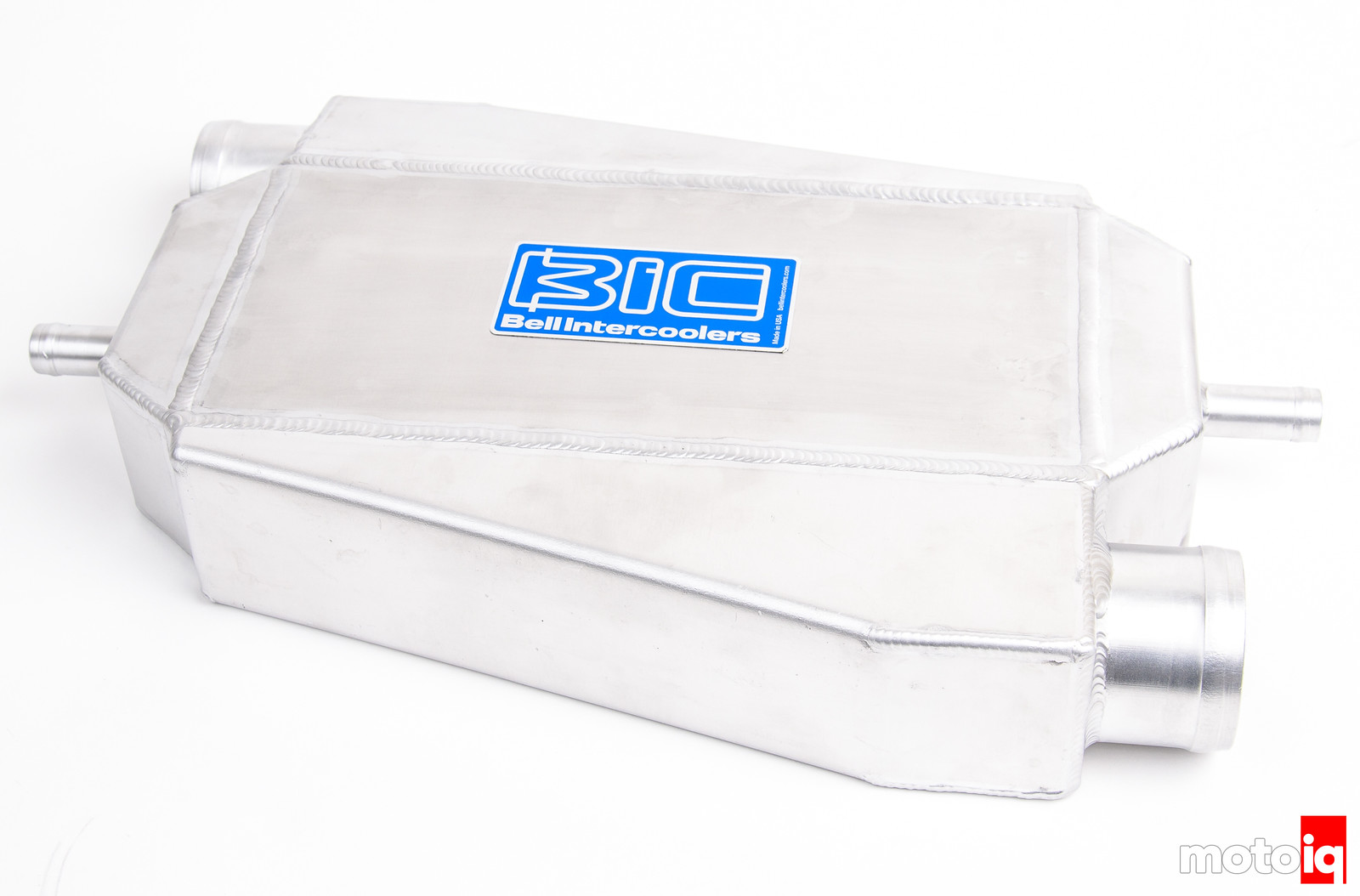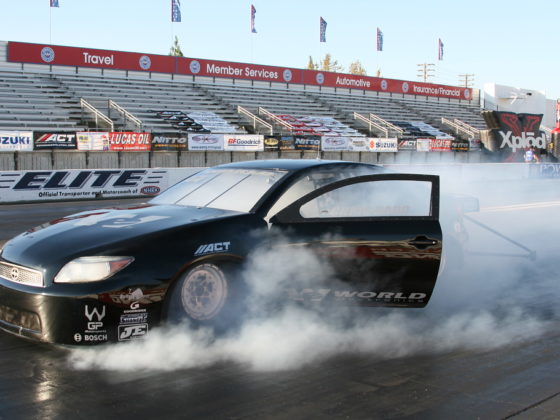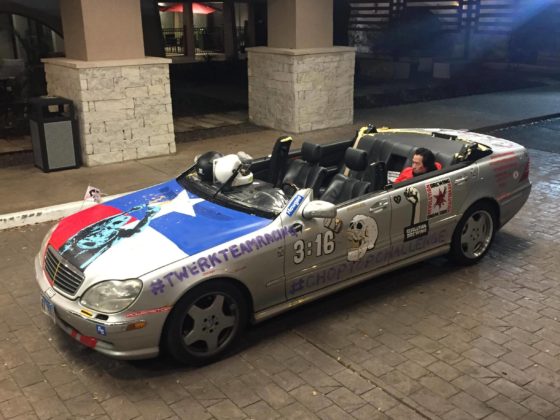
About two weeks after my initial sketch, I had the final product from Bell Intercoolers in my hands. It was fabricated in San Antonio, Texas, so being made in the USA cut down on shipping. I could have had it even faster if I paid for quicker shipping, but there is no rush and I need to save money where I can. The intercooler came very securely packed to prevent shipping damage. The intercooler was sealed in a bag and all the hose connections had red caps to prevent anything from getting into the intercooler. Notice the water end tanks have a depth of 1.5” to allow for good water distribution across the core.

Looking inside the air inlet side of the intercooler, you can see the air guide to help get more equal flow distribution across the core for better effectiveness. This side has the 2” inlet, so the end-tank has a slight taper. You can see how the air will have expand just a little bit going into the end tank.

On the outlet side with the 2.5” hose connection, the airflow has to make a minimal step. An important characteristic of the air-to-water core is the difference in flow path heights for the water flow and the air flow. We couldn’t get a good picture through the small ¾” hose barb for the coolant, but if you look inside, can you see the coolant flow paths through the core are smaller. Coolant having much higher heat capacity than air requires much lower flowrate. So, in an air-to-water core, the flow path width is biased to be greater for the airflow which also reduces the airflow pressure drop. We definitely like minimal airflow pressure drop.

I measured the front bumper opening at roughly 27” wide and 6” tall. In the middle is the receiver/dryer for the air conditioning system.

The distance from the receiver/dryer to the back of the black plastic grill is about 2”.




24 comments
Not to be a party pooper, but:
A heat exchanger isn’t based on Horsepower ratings of an engine, but on heat dissipation. So 500bhp or 550 bhp say nothing. If you want a refference, you’d best look at boost pressure. Boost pressure is in essence restriction, so thats where heat comes from. My guess is that the Shelby runs signifficantly less pressure then you S2000 will, so that makes the system a lot less efficient.
But I could be wrong, as I dont know your specs or the specs of the shelby for that matter?
You are correct. While the heat rejection capability of the heat exchanger is really a ‘it depends’ type situation, my operating parameters are ‘close enough’. The 2012 Shelby GT500 runs about 10psi of boost out of the roots supercharger. I’ll be pushing a little less mass flow at a higher boost pressure of ~15psi. But The G25-660 compressor is much more efficient than the blower, so that’ll reduce the deltaT difference due to the higher boost pressure. Plus I’ll be running the water pump 100% of the time and have the sucker fans on the heat exchanger to keep the bulk coolant temp as low as possible, neither of which the GT500 does/has.
I hope for you it’ll work, but I’m guessing its putting to much strain on the pump. and lets not forget about amps that are drawn by the whole setup. I would have just kept it stupid simple: air to air intercooler: temp sensor for a spraybar and a tank placed in convenient location.
I do hope it works though!
Pump is going to pull round 8 amps. Yeah, I thought about KISS and going air-to-air and saving money, but, I’m only ever going to do a project like this once and I want maximum throttle response. So I figured I’d give it a shot and it’ll be a good learning experience.
I can understand that and support that! The end results, when it works, are always more satisfactory.
The main reason for the OEM’s to go water cooled intercooler is not so much peak performance. It’s more or less done because of warranty: No heat soak is less likely for detonation to occur. I believe Subaru had a spray on a certain STI I believe? But as far as I know deleted it as it didn’t get filled regularly. Long live ordinary people and car maintenance (or better the lack thereoff)….
Ex F1 engineer vs Ex turbo engineer, good stuff!
Khiem, any plans to throw a shroud on the heat exchanger?
I think 8 amps is a fine compromise to constant coolant flow, and should be within the available surplus of current provided by the stock alternator. You may even be able to rig up one of meziere’s PWM controllers to slow the pump under certain conditions.
Shouldn’t need a shroud, but will know for sure once the heat exchanger is mounted. The heat exchanger should be right up against the black plastic inlay in the front bumper opening and basically cover up the entire front opening. I thought about maybe using a pump controller based on temperature, but that adds some complexity.
Khiem, I have a few questions for you, but will post them separately since they are on different topics.
First topic: I have read the past S2000 posts awhile ago. But, I forget if this is a n AP1 or AP2. I am assuming that this is the 2.0L AP1 for now.
In terms of budget did you do a comparo vs a AP2 2.2L w/ off shelf Vortech Centrifugal Supercharger. Seems to be around $4000 for 70-80 hp.
Obviously, not the greatest power, but I am sure there’s some tweaking you can do like water injection or new pulleys.
Also, for a 250hp power increase I assume some chassis/tire modifications will be required. What size tires/spring/damper modifications are you considering. Also, the AP1 wasn’t too stable with stock power. What kind of ARB, or traction control are you thinking of? Any aero modifications? Rear diff? Any tranny/driveline modifications? I know that this is SoCal, but it rained a bit this year. Is this thing going to be remotely drivable in the rain? Are you going to limit torque in low gears? Is there any thing that you can do about weight distribution to enhance traction? I know that you don’t have much space in the back, but can you at least do a battery relocation?
Mine is an AP2, so 2.2L. Technically, more like 2.157L 🙂 With the centrifugal blower, the boost increases with RPM. So there’s still no mid-range torque. There’s really not much gain until after 5k rpms. A roots style blower would give more of the powerband I’m looking for, but turbos are more efficient. And I can adjust boost by gear or whatever I feel like running that day.
My suspension and wheel/tire package is set. I’ll likely just tweak the front camber and rear toe to rebalance the handling. I would like to get an OS Giken rear diff, but man that thing is expensive! Maybe sometime in the future. It’ll be perfectly drive-able in the rain, just have to stay out of the throttle 🙂 No traction control, but Hondata does sell a traction control module. But I prefer to just use my right foot. Not going to relocate the battery, but maybe upgrade to a li-ion sometime down the road. No aero mods the car will have all stock body panels.
https://m.youtube.com/watch?v=3D4l4TUj8sQ
The second topic is about the DualBoost Axial flow turbine design. I know you are probably still under NDA, so if you can’t answer any of my questions, I totally understand. I just saw this new video on the Porsche 919, and saw how it was installed, so naturally it got me thinking.
Obviously, after watching the video the engine mapping is managing boost pressure. Since axial flow turbines don’t like to change rotation speed that makes sense to me. The exhaust merges similar to a twin scroll, but obviously it collects both banks of exhaust flow similar to a 4-2-1 header, but the flow is collected before the turbine, not in the turbine housing like a twin scroll. I assume that this where the DualBoost name comes from.
Also, I see two exhaust outlets of the same diameter but from close examination one looks to be a wastegate and the other is the exhaust from the axial flow turbine outlet. To have identical diameters suggests to me that they must both flow nearly identically, meaning that the wastegate is operating nearly constantly. You can see a heavy bundle of wires routed to the wastegate so it must be computer controlled. This makes sense considering the engine dynamics reported by Chris Harris. I can only surmise that boost is nearly instantaneous from very low revs. This is pretty impressive from a V4 that I assume fires every 180 deg of crank rotation. I can only imagine how incredible a DualBoost would be with a V12, and even a V8.
This is really exciting technology, and I am absolutely dying to see it on the consumer market. I am sure you are still under NDA, but do you have any idea when it might show up? Are we another decade out? I am pretty certain that a DualBoost hybrid power train will be the absolute most promising racing tech in my lifetime. At least, on the power train side of things.
Looks like Garrett just released an updated video and they have something now called DualBoost Twin-Flow.
https://www.garrettmotion.com/news/video-center/video/dualboost-twin-flow/
No clue on the turbo making it to production, but you can bug Mike Stoller about it. He posted his email in the comments section of my article on the DB:
https://motoiq.com/the-secret-turbo-in-the-ring-slaying-porsche-919-evo-honeywell-garrett-dualboost-for-gasoline-turbocharger/
With gas turbo engines, at WOT, the wastegate flow is typically like 30%-40% of total flow. On the 919, all that wastegate flow goes through a turbine which spins an electric generator, so basically waste heat recovery. With a track like Le Mans where the car is at WOT for long stretches, it generates a lot of energy!
Wow. So friggin’ cool. If this makes it to the consumer market, I am sold. Take my money!
I’ve used that exact water pump and have gone back to the bosche. Like you, I had the same arguments for the meziere, but in my (limited) experience it was disappointing. The meziere draws a good amount of current, and it did flow more than the bosche, but I didn’t see any difference on the dyno nor on my AITs on the street. It draws enough current that I would not recommend using the ACC function. It will drain your battery faster than you think. Additionally, that pump is LOUD. When idling, you’ll hear it over all other engine/exhaust/supercharger noises.
I’m SC’d at 23 psi on a built AP1, oem header/exhaust/TP.
The meziere lasted about 10k .
Hmmm……. I’m trying to avoid loud…. did you have it hard mounted, metal-to-metal? I’ll have to go hook up some power to it to see how loud it is just sitting out. Thanks for the heads-up.
I did have it hard mounted. I’m sure rubber isolators would help, but the difference betweeen the two was stark. Inside the cabin I can barely hear the bosche-I have to be listening for it to hear it. The meziere is EASILY heard inside the cabin. It was louder than my blower. All this said, the meziere visibly flows more -you’ll see faster moving fluid in the aftercooler. I just didnt see any hp difference, and technically, faster moving fluid should be advantageous for cooling.
I really don’t rate the bosch pumps at all, they are prone to failure, were only designed to operate at .3bar (4.41psi) and are quite a large bodied unit for the flow rate. If you have any issues with the meziere, there are some you should consider:
Johnson CM30 – smallest of the pump, generally flows the same as a bosche, more compact
Johnson CM90 – bigger unit, more flow. Rated for 5,000hrs use, and 30 mins dry run time
Pierberg CWA100 – Pick of the bunch. OEM pump of choice for a lot of BMW and AMG IC pumps. Brushless motor. It is PWM controlled, but you can easily make a controller setup, or buy something from tecomotive or the like. 8.5A current draw. Were the factory pump for the 13-14 GT500 i believe, when they ditched the bosch units
Great info! I’m digging the Pierberg… I have a bit of indirect experience with them. I’m really liking them being brushless. At my current job, we have some brushed water pumps failing on us and replacing with brushless. I see Pierberg offers their “tinyCWA” controller with lots of cool features. Probably overkill for me as I was intending to just run the pump full speed all the time. It looks like I can buy a generic 12V input, 0-10V PWM output controller for like $10.
I am thinking about going from the Bosch, which I consider to be pretty bad/low flow to the CWA100. I assume this is a worthwhile upgrade?
Where can I purchase that liquid intercooler, that will work for my airboat.
rickyperry21@gmail.com
Bell Intercoolers can custom design anything you want. At the bottom of the page in the link how to contact them for getting an IC made to your specs.
https://bellintercoolers.com/p-37042-charge-air-coolers-intercoolers.html
Water outlet needs to be at highest point , otherwise there will be a dead area with no water flow , unless you have some means of bleeding the air out !
Yup. I’m currently debating what to do… Either get the air out by install process (hold IC vertical while filling the system) or adding a bleed port to the outlet side of the IC. Notice the outlet port is in the middle of the end tank, so air can definitely get stuck there. So, I’m thinking of a little bleed port at what will be the highest point in the end tank. I know it been a very long burn…. but the car should be completed in about two months Hopefully.
I am surprised that the Bosch pump tested well? On paper it flows very poorly compared to something like a CWA100. I have the Bosch and I can’t give you a flow number but it looks pretty pathetic. The CWA100 is ($300) but I expect like double the flow.